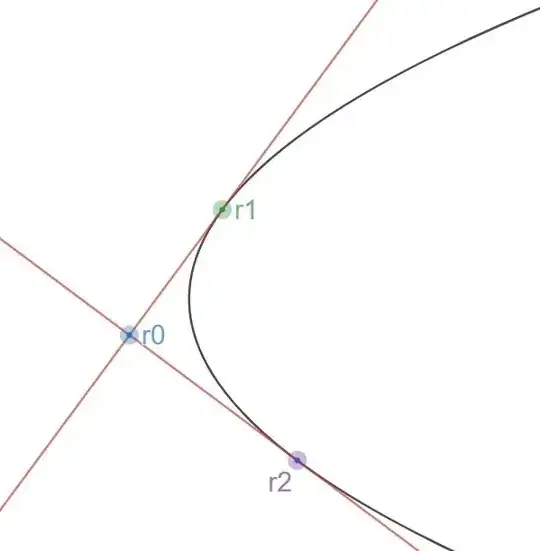Let $$\textbf M=\begin{bmatrix}a & h & g \\ h & b & f \\ g & f & c\end{bmatrix} \qquad \textbf r=\begin{bmatrix}x \\ y \\ 1\end{bmatrix}\qquad \textbf{r}_k=\begin{bmatrix}x_k \\ y_k \\ 1\end{bmatrix}\qquad \mathrm d\textbf{r}=\begin{bmatrix}\mathrm dx \\ \mathrm dy \\ 0\end{bmatrix}$$ Then equation of conic is $\mathrm S \equiv\textbf{r}^{\mathrm T}\textbf{Mr}=0$
Firstly, $\ \vec{\textbf a}^{\ \mathrm T}\textbf{M}\vec{\textbf b}=\vec{\textbf b}^{\ \mathrm T}\textbf{M}\vec{\textbf a}$
Next, $\mathrm {dS}=2\textbf{r}^{\mathrm T}\textbf{M}\mathrm d\textbf r$
Equation of tangent at $\textbf r_1$ is $\textbf{r}_1^{\mathrm T}\textbf{M}\textbf r=0$
Equation of Chord of contact from $\textbf r_0$ is $\textbf{r}_0^{\mathrm T}\textbf{M}\textbf r=0$
My attempts for proving $\mathrm{T^2=SS_0}$ is the pair of tangents.
The pair of tangents is $(\textbf{r}_1^{\mathrm T}\textbf{M}\textbf r)(\textbf{r}_2^{\mathrm T}\textbf{M}\textbf r)=0$
- Sub Goal: to find a relation among $\textbf{r}_0$,$\textbf{r}_1$ and $\textbf{r}_2$
The equation $(\textbf{r}_0^{\mathrm T}\textbf{M}\textbf r)^2-(\textbf{r}^{\mathrm T}\textbf{Mr})(\textbf{r}_0^{\mathrm T}\textbf{M}\textbf{r}_0)$ passes through $\textbf{r}_0$,$\textbf{r}_1$ and $\textbf{r}_2$. Thus if it is a degenerate hyperbola, then we are done.
- Sub Goal: $\det(\textbf{M}\textbf{r}_0\textbf{r}_0^{\mathrm T}\textbf{M}-(\textbf{r}_0^{\mathrm T}\textbf{M}\textbf{r}_0)\textbf{M})=0$
Assuming pair of tangents can be written as $\mathrm{T^2-\lambda S - \mu T}=0$. Now equating slopes at 1 and 2 reveals $\mu =0$ and and since it passes through 0, we get $\lambda=\mathrm S_0$
- Sub Goal: proving the assumption.
